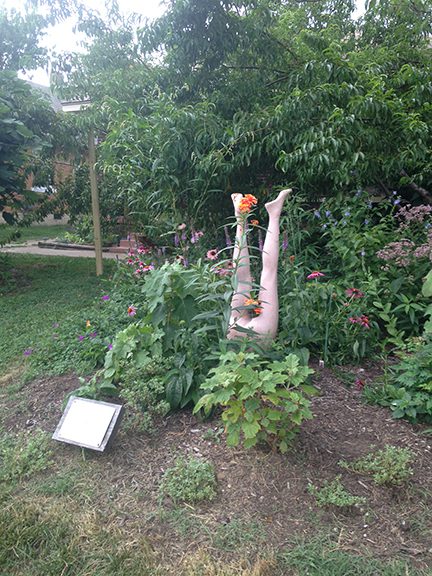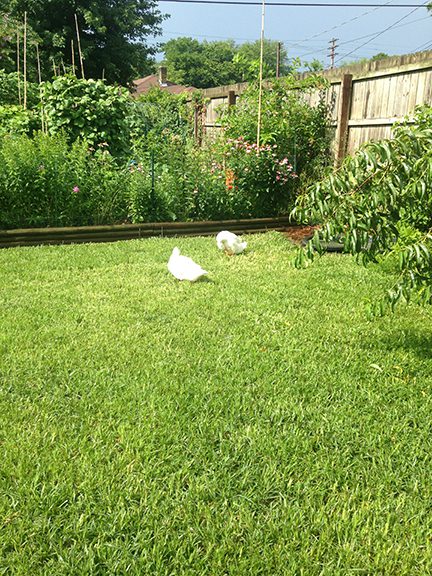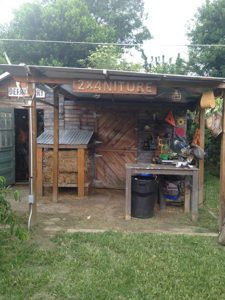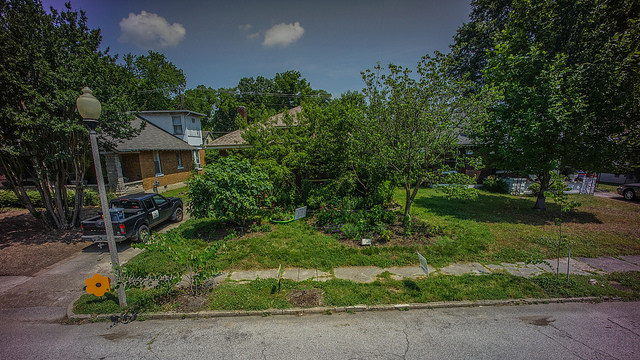By Sharron Johnson
I jumped in the car and caught the tail end of a story on NPR that Pixar’s animated film WALL-E had recently turned 10 years old. 10 years? No, can’t be. For those of you that never saw the film, WALL-E (an acronym for Waste Allocation Load Lifter: Earth Class) is a determined robotic trash collector/compactor. He was sent to a trash covered earth to crush the trash into cubes, so it could be in incinerated on the ship. The humans, all now living on a spaceship, have abandoned earth because it’s not sustainable to life because of over consumerism. The captain of the ship is eagerly wanting to return to Earth and sends a fancy reporter robot named EVE to let the humans know of the state of the Eearth and when they could return. In order to return, plant life must inhabit the planet. WALL-E discovers a lone plant left on earth. In the meantime, he finds love and purpose. Saving Earth and EVE, his special lady.
The news brought back memories of how I felt after first seeing the film. For instance, bewildered over how art imitates life. Even today, humans are slowly destroying the earth with chemicals and poor plant management. Another was wonder at how love concurs all. No explanation needed on love. And lastly, the importance of never losing hope. Even a glimmer of hope is all the average human needs to push on through any hardship. We humans, like in the film, are obsessed with our screen time and neglect nature and consumerism. I’d like to think that mankind can and must undo poor stewardship of Mother Nature and turn back the hands of time. How, you may ask? We can change our footprint story by changing our consumption of mass produced items, like food and durable goods. Start by adding edibles and native plants to your landscape instead of lawn grass. Add in food from local farmers and restaurants to your diet. Also, look for used items instead of new. Repurposed items are unique and keep the landfill at bay. Practice recycling back into the soil through composting spent items like raw kitchen scraps, leaves, and yard waste. This will eliminate the need for chemical use by producing microbes. It will save money, promote better health, and you will love the way it makes you feel just knowing that you are contributing to a better life for everyone. One person at a time is a slower process, but if everyone reading this starts right where you’re at, well, you know, hope.
I pride myself on the knowledge I’ve obtained in my 54 years on the planet. Definitely not a Rhodes Scholar on any subject but well versed on working in the yard. At least I thought I was until I met Mike Larrivee. He is this month’s Yard of the Month. I am humbled by his mission. The Wall-E character reminds me of Mike. He is driven by a mission of love and hope. Let me start at the sidewalks edge.
To get to Mike’s farm, yes farm, we need to travel west on Nelson, close to the most western boundary of the northwest quadrant, to 1846 Nelson. A homestead, indeed. When walking up to this property, you notice the lawn is a variety of grasses like Bermuda, fescue, crab, Johnson … whatever nature sprouts. Chemicals aren’t welcome in this space. The property is designated as a National Wildlife Federated Garden. There is a sign perched on the porch that says so.
It’s refreshing to see a sense of humor expressed with a grand art piece perched prominently in a circular flower bed. The piece sits among the native flowering plants, arboretum trees, and various vining ground covers. It’s a lower half of a female mannequin, void of clothing and placed upside down to seem as if she was an ostrich with her head in the sand. There are red silk flowers strategically perched in one set of toes. A full-figured fig tree stands right off the sidewalk greeting all passersby, creating a cooling oasis that any shade loving plant would be envious of. The fig tree is listed on the Cooper Young Arboretum list. There are also two types of peach, downy serviceberry and a black tupelo all in this small plot. The beds wrap around the house foundation and are so packed with plants that there is very little room for weeds.
Potted plants lead the visitor up the porch stairs to a cozy seating area secluded from street view. Some of the planters are handmade from pallets and repurposed wood. Normally, I’d describe every plant. In this instance, there are so many that I had Mike list them. There are close to 90 species of plants and trees.
This is a 1922 dark red brick bungalow sporting a white trim. The house is the supporting actor in this movie. Plants are the Star. Down the driveway, climbing the brick, are blackberry, raspberry, and black-eyed Susan. They are basking in an ever-present southwest sun shine. The drive isn’t all concrete. At the top of the drive are grasses, dandelion, purslane, and gravel to keep the water from rushing down the drive to the street gutter. Water ecology is enforced here by capturing in rain barrels or slowing the runoff. All the beds are edged in a landscape timber that have the same water slowing effect.
Enter the back acreage through a wooden gate opening up to a wide berth of the same grasses as the front garden. An aluminum A-frame ladder is being used as a trellis for a squash vine placed smack dab in the middle of the seasonal grass which comes in during the summer months. A gently used claw foot bath tub is used as a planter and anchors the garden entrance. There are seven raised garden beds chock full of food sources for Mike and his extended family and friends. A bee hive, a four pack of chickens, and a couple of ducks along with a turkey that rounds out his city menagerie that reside in the back garden. This homeowner won my heart when I saw he has an old school clothesline. I can’t live without mine. Mike even builds furniture in this space from recycled wood. This is a fully developed sustained space. I feel certain that if you knocked on his door and asked him for a tour, he would abide.
 Mike, where do you hail from?
Mike, where do you hail from?
I grew up on the seacoast of New England, and came to the south from Seabrook, NH. I lived in Texas and Louisiana while I was in the Air Force and came to Memphis in 2001 to play music. I left to live in Europe for a few years but came back to Cooper-Young in 2012. This place resonates in me. I feel like there’s a reason I’m here!
What brought you to the Mid-South and to Memphis?
Oh gosh, I guess I already answered that one! I came to Memphis to be a musician. It seemed logical because of the central location, low cost of living, and amazing talent pool to draw from. It worked out for a while.
Are you from a large family?
Just one younger sister. I had close cousins and lived up the hill from my nana. We had a gigantic subsistence garden and an orchard that I worked with my dad. I grew up on the former dairy farm my papu started when he moved to America from Greece, and I had room to start a Christmas tree farm and dig a 3/4 acre catfish pond. It’s been interesting being an urban farmer. You learn how to be economic with space!
Married? Single? Children? Fur or feather babies?
I tried being married, but I can’t add that to my list of skills. I have an Air Force baby named Brody that will be able to buy a legal beer in November. On most days, he’s the only thing that reminds me that I’m not 26. I have a special lady that I’m crazy about. I also have a Theo. He helps me take care of Daisy Mae (100 lb. hound dog) and he added Carlos the swamp rate to the family. Tiny and Billy are cats, but they think they’re gods. We have 4 chickens, two ducks, and a guard turkey named Penny. Roughly 10,000 worms in cultivation at any time and roundabout 100,000 bees this time of year. See the attachments for a list of worm and bee names.
Have you been interested in plants and dirt most of your life?
I’m bananas about living systems. Seeing how all the pieces fit together and learning how to restore functions that have been lost in our ecosystems really blows my skirt up. I turned the corner on the critical need we have to use native plants in our landscape when I learned about Doug Tallamy. I’m a little bit of a bully about it.
That being said, I have a toad lily and my gramma’s irises in my landscape. Lots of the annuals and some of the trees that I grow for food are from Europe and Asia, genetically at least. I’m learning and leaning heavily on native food plants now. Pawpaw, persimmon, hazelnut, serviceberries, muscadine. They all grow so easy here! No diseases, or really any problems to speak of. And they look cool.
Dirt is what we all need to learn to grow. Our version of soil maintenance and land stewardship is killing us. Y’all, please stop bagging your leaves and start mulching with them. Bagging them up and throwing them out is just dumb.
Why did you choose the home at 1846 Nelson and how long have you lived there?
I knew this house was mine as soon as I saw it. I sat on the porch rail and knew that I’d be looking out on this part of the neighborhood for a long time. Beyond that, it was a rental and had been treated as such for a long time. Lots of cheap fixes and cut corners. Fortunately, the bones of the house are rock solid and I’m handy so I got it for a song.
 What was your garden like when you moved in?
What was your garden like when you moved in?
That was the other big reason I wanted my house. The yard was crap. The whole west side of the back was concrete, and the only tree was a tree of heaven. Worst tree ever behind the Bradford pear. I cut it down and made a throne out of it. I smashed up the concrete with a sledge and dumped right around 400 bags of leaves I picked up off the curb in the excavation. Didn’t buy an ounce of dirt. There’s a foot of topsoil there now. Check it with hand auger sometime! Did you know an earthworm can move a moldy leaf more than a meter vertically through the soil profile? I just love earthworms.
Not everyone in the neighborhood knows or has even heard of you. Maybe they missed the May issue of the Lamplighter, which gave a pretty in-depth story of you and your mission. So, indulge us with a quick rundown of your occupation and the nonprofit you’ve started.
Ha! This’ll be fun. Technically, I’m a licensed professional geologist. Academically, my training is more geography and biology. I was just in school for a long time and I’m good at tests so I passed the board to get my license. I’m a project scientist for an environmental consulting firm that’s focused on remediation. Mostly petroleum, but we fool with heavy metals, chlorinated solvents, PCBs, and organochlorides (agricultural chemicals). The ag chemicals are the worst. They can penetrate a nitrile glove. I can’t believe we grow our food with that poison.
I started the Compost Fairy when I bought my house. I’m cheap like my dad and don’t like to buy things so I put out an ask to the neighborhood to see if anyone would give me kitchen scraps. I planned on making all the dirt I needed for my kitchen garden instead of buying it. Holy cow, did I get a response! There was quickly more than I needed personally. I didn’t want to break the momentum of sustainable practice that had happened, so I started collecting at the farmers market on Saturdays. All the material we collected went out to Loch Holland Farms in Saulsbury to help rebuild the soil in the pastures. Chris and Claire did an amazing job with the land out there.
Late last year Compost Fairy organized as a non-profit and we started a curbside pickup service. We’re growing fast3 and are hoping to create good, sustainable employment for folks here before too long. We’re making great compost out of all the stuff we’re collecting and putting it back in to our community as a soil builder. I’d love to have the whole neighborhood involved. We built a great website that we update with news about what we’re doing at compostfairy.com.
How long have you’ve been gardening using native plants?
Native trees have been a thing with me for a minute, but I’m focusing on biodiversity and planting with density these days. This lawn and sea of mulch in our flower beds, things we’ve all bought into, is insane. Plant a little denser and, really, you’ll only need mulch as a side dress fertilizer. And it looks awesome. Come by and have a look!
Your garden has been certified as a National Wildlife Habitat. When did this take place and what all is involved in this process?
I did that a couple of years ago. It’s a fairly simple process. You have to be able to demonstrate that you have a certain amount of native plants that support local wildlife, a water source, sufficient cover, and sustainable land management practice. There are state level certifications that are helpful as well. Handy when it comes to some situations. I’d had trouble getting the county to honor my request to be on the “no spray list” and not spray permethrin all over my property. That’s not a problem any longer.
What are your future plans for you urban garden?
Man, it’s filling in nicely now. I’m really just enjoying watching all my green babies grow up. I’m hunting a baptista, because I really like bumblebees. I’m planning on expanding the duck pond to incorporate some hydrophytic plant material. That’ll be fun!
I personally don’t know much about going native but am willing to learn and then spread the gospel. Where should the novice start?
Read Bringing Nature Home by Dr. Doug Tallamy. I had more epiphanies reading that book than any other that I can remember. I like it when I feel dumb, because it means I’m learning. There are great resources elsewhere for lists of plant material. Xerces Society has it broken down by region, and they have a great mission. Dabney Nursery has tons of native plant material and a super knowledgeable staff.

Do you have an all-time favorite plant and why?
I drove by a catalpa tree (C. Bignonioidies) this morning. That’s a sexy tree. Everything about it. It has the most beautiful habit of any tree in the southeast, for sure. But yeah, leaves, bark, fruit, flowers. It’s the total package.
I also love a black-eyed susan (R. Hirta). They’re tough little survivors. The sparrow of the wildflower kingdom.
If there was anything you could change about Cooper-Young, what would it be?
I love this neighborhood. We could do with a little bit more public space. Pocket parks are so easy. The annex west of Spanish American War Park would be great. Sure hope that works out.
Is there a book to write about native gardening in your future?
Ha! Sure. With all my spare time.

